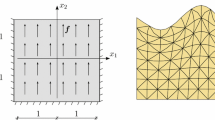Abstract
In this paper we discuss the use of single and double layer boundary integral equations for the numerical solution of linear elasticity problems with boundary conditions of mixed type, and the one-equation coupling of finite and boundary element methods to solve a free space transmission problem. In particular we present a sufficient and necessary condition which ensures stability of the coupled approach for any choice of finite and boundary elements. These results justify the coupling of collocation and Galerkin one-equation boundary element methods with finite elements as used in many engineering and industrial applications. Hence one may avoid the use of the symmetric formulation of boundary integral equations, which is, although well established from a mathematical point of view and also used in some engineering applications, not so much accepted in particular in industrial applications.
Similar content being viewed by others
References
Bonnet M (1999) Boundary integral equation methods for solids and fluids. Wiley, Chichester
Brezzi F, Johnson C (1979) On the coupling of boundary integral and finite element methods. Calcolo 16: 189–201
Brink U, Stephan EP (2001) Adaptive coupling of boundary elements and mixed finite elements for incompressible elasticity. Numer Method Partial Differ Equ 17: 79–92
Costabel M (1987) Symmetric methods for the coupling of finite elements and boundary elements. In: Brebbia CA, Kuhn G, Wendland WL (eds) Boundary elements IX. Springer, Berlin, pp 411–420
Costabel M, Stephan EP (1990) Coupling of finite and boundary element methods for an elastoplastic interface problem. SIAM J Numer Anal 27: 1212–1226
Gatica GN, Hsiao GC, Sayas F-J (2012) Relaxing the hypotheses of Bielak–MacCamy’s BEM–FEM coupling. Numer Math 120: 465–487
Han H (1994) The boundary integro-differential equations of three-dimensional Neumann problem in linear elasticity. Numer Math 68: 269–281
Hsiao GC (1990) The coupling of boundary element and finite element methods. Z Angew Math Mech 70: T493–503
Hsiao GC, Steinbach O, Wendland WL (2000) Domain decomposition methods via boundary integral equations. J Comput Math 125: 521–537
Hsiao GC, Wendland WL (1977) A finite element method for some integral equations of the first kind. J Math Anal Appl 58: 449–481
Hsiao GC, Wendland WL (2008) Boundary integral equations. Applied mathematical sciences, vol 164. Springer, Berlin
Johnson C, Nédélec J-C (1980) On the coupling of boundary integral and finite element methods. Math Comput 35: 1063–1079
Kupradze VD (1979) Three-dimensional problems of the mathematical theory of elasticity and thermoelasticity. North-Holland, Amsterdam
McLean W (2000) Strongly elliptic systems and boundary integral equations. Cambridge University Press, Cambridge
Of G (2007) Fast multipole methods and applications. In: Schanz M, Steinbach O (eds) Boundary element analysis. Mathematical aspects and applications. Lecture notes in applied and computational mechanics, vol 29. Springer, Heidelberg, pp 135–160
Of G, Steinbach O (2003) A fast multipole boundary element method for a modified hypersingular boundary integral equation. In: Efendiev M, Wendland WL (eds) Proceedings of the international conference on multifield problems. Springer lecture notes in applied mechanics, vol 12. Springer, Berlin, pp 163–169
Of G, Steinbach O (2011) Is the one-equation coupling of finite and boundary element methods always stable? Berichte aus dem Institut für Numerische Mathematik, Bericht 2011/6, TU Graz
Of G, Steinbach O (2012) Stable coupling of finite element methods and one-equation boundary element methods. Berichte aus dem Institut für Numerische Mathematik, Bericht 2012/1, TU Graz
Of G, Steinbach O, Urthaler P (2010) Fast evaluation of Newton potentials in boundary element methods. SIAM J Sci Comput 32: 585–602
Of G, Steinbach O, Wendland WL (2005) Applications of a fast multipole Galerkin boundary element method in linear elastostatics. Comput Visual Sci 8: 201–209
Rjasanow S, Steinbach O (2007) The fast solution of boundary integral equations. Mathematical and analytical techniques with applications to engineering. Springer, New York
Salvadori A (2010) Analytical integrations in 3D BEM for elliptic problems: evaluation and implementation. Int J Numer Methods Eng 84: 505–542
Sauter SA, Schwab C (2011) Boundary element methods. Springer series in computational mathematics vol 39. Springer, Berlin
Sayas F-J (2009) The validity of Johnson–Nédélec’s BEM-FEM coupling on polygonal interfaces. SIAM J Numer Anal 47: 3451–3463
Sirtori S (1979) General stress analysis method by means of integral equations and boundary elements. Meccanica 14: 210–218
Steinbach O (1998) Fast solution techniques for the symmetric boundary element method in linear elasticity. Comput Methods Appl Mech Eng 157: 185–191
Steinbach O (2000) Mixed approximations for boundary elements. SIAM J Numer Anal 38: 401–413
Steinbach O (2003) A robust boundary element method for nearly incompressible linear elasticity. Numer Math 95: 553–562
Steinbach O (2008) Numerical approximation methods for elliptic boundary value problems. Finite and boundary elements. Springer, New York
Steinbach O (2011) A note on the stable one-equation coupling of finite and boundary element methods. SIAM J Numer Anal 49: 1521–1531
Steinbach O, Wendland W (2001) On C. Neumann’s method for second order elliptic systems in domains with non-smooth boundaries. J Math Anal Appl 262: 733–748
Wendland WL (1988) On asymptotic error estimates for the combined BEM and FEM. In: Stein E, Wendland WL (eds) Finite element and boundary element techniques from mathematical and engineering point of view. CISM Lecture Notes, vol 301. Springer, Wien, pp 273–333
Author information
Authors and Affiliations
Corresponding author
Rights and permissions
About this article
Cite this article
Steinbach, O. On the stability of the non-symmetric BEM/FEM coupling in linear elasticity. Comput Mech 51, 421–430 (2013). https://doi.org/10.1007/s00466-012-0782-y
Received:
Accepted:
Published:
Issue Date:
DOI: https://doi.org/10.1007/s00466-012-0782-y



